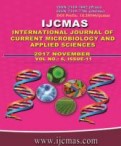


 National Academy of Agricultural Sciences (NAAS)
National Academy of Agricultural Sciences (NAAS)

|
PRINT ISSN : 2319-7692
Online ISSN : 2319-7706 Issues : 12 per year Publisher : Excellent Publishers Email : editorijcmas@gmail.com / submit@ijcmas.com Editor-in-chief: Dr.M.Prakash Index Copernicus ICV 2018: 95.39 NAAS RATING 2020: 5.38 |
Gut micro-organisms have the ability to adapt themselves to changes in insect diet and the enzyme activity fluctuates in response to dietary changes. A total of 72 dominant isolates was successfully collected from the intestine of the fourth and fifth instar silkworm larvae fed with fortified mulberry leaves. The isolates represented 12 phenotypical forms on nutrient agar plates. Eleven phenotypes existed in the intestine of the larvae fed with mulberry leaves supplemented with Aloe vera and Tinospora cordifolia and ten found in larvae fed with only mulberry leaves. Ten of them were common in the intestine of three groups. The total highest cultivable bacterial count found to be 4.82 ± 0.446 x106 and 6.32 ± 0.269 x106 CFU/ml of B. mori larval digestive tract suspension of fourth and fifth instar respectively. The results showed that the clearing zone and hydrolysis capacity value of cellulose, starch and lipid degrading bacteria were found to be highest in treated groups compared to control. The enzyme assay for cellulase, amylase and lipase activity was found to be highest for BMGB42 isolate with 0.428, 1.02 and 11.33 (U/ml/min) respectively. The results indicate that the diet had significant impact on the gut bacterial community and enzyme activity. It was also observed that there was a proportional increase in the total bacterial count as well as percent dominance of cellulase, amylase and lipase with respect to the growth of B. mori.
 |
 |
 |
 |
 |